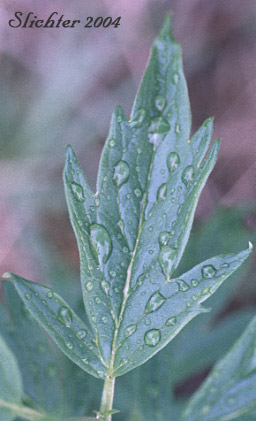 The
photo at right shows a stem leaf of tall phacelia as seen along Reecer Creek Road
in the Wenatchee N.F.........June 22, 1997.
The
photo at right shows a stem leaf of tall phacelia as seen along Reecer Creek Road
in the Wenatchee N.F.........June 22, 1997.
Tall phacelia is a perennial wildflower with one to several erect, stout stems from 50-200 cm high. The herbage is generally green with straight, stiff hairs closely appressed to the stems and leaves. The stems below and within the inflorescence are conspicuously black-glandular. Basal leaves are lacking, but the numerous stem leaves are petiolate with blades up to 12 cm long and up to 7 cm wide. The blades are pinnately divided or few-lobed, the terminal segment the largest of the 3-7 segments. The lower stem leaves are reduced in size and may be lanceolate in shape with entire margins while the largest, lobed leaves are near mid-stem.
The inflorescence consists of several scorpioid cymes loosely to fairly tightly clustered into terminal, corymbiform clusters. The calyx lobes are oblong-lanceolate to linear in shape, about half as long as the corolla, and covered with glands. The bell-shaped corollas are pale greenish-white, averaging 5-7 mm long and 5-9 mm wide. The stamens are strongly exserted beyond the corolla. The style is 2-cleft about three-fourths of its length.
Tall phacelia is a plant commonly found in meadows an in open to lightly forested slopes at moderate elevations in the mountains.
Tall phacelia may be found from the eastern slopes of the Cascade Mts. and Wenatchee Mts. of Washington south to the Sierra Nevada and Coast Ranges of northern California and in the Blue Mts. or north-central Oregon and east into Idaho.